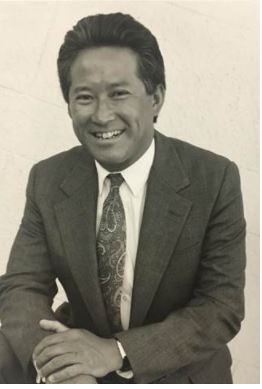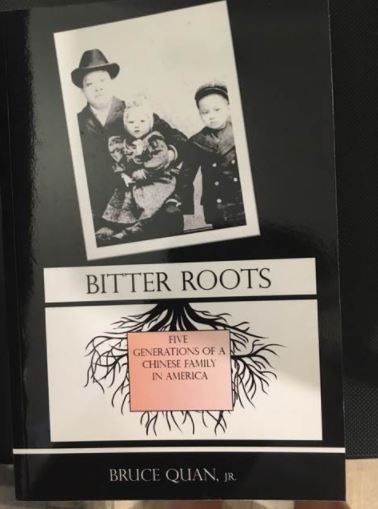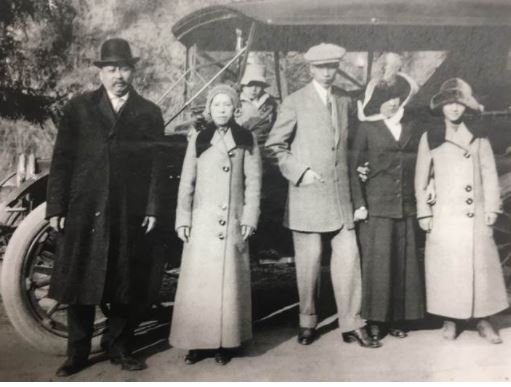By Raymond Douglas Chong, AsAmNews Staff Writer
Bruce Quan, Jr., a fifth generation Californian has written a book, Bitter Roots: Five Generations of a Chinese Family in America, about the impact of racial prejudice on his family, from the arrival of his ancestors in 1850’s to the present.
Highlights
The key highlight of the book is Part One: The Rise and Fall of the First Chinese Industrialist in America.
The Author’s great grandfather, Lew Hing emigrated to San Francisco at the age of eleven in 1869 to help his half-brother at his dry goods store, Hing Kee on Commercial Street in Chinatown.
Two years later, when his half-brother perished on a voyage back to China to visit his wife and son, Lew was left to run the family business. Recruiting a fellow countryman from the Sze Yup region of Kwangtung province, he later made him a partner. Lew left him in charge, as he sought business opportunities.
Though a White customs broker, Lew pursued his dream of manufacturing canned goods, a new and lucrative business in America. The White broker helped him first obtain employment in a tin making business. Afterwards, he started his own shop. He then left the shop to be run by trusted employees and again, the White friend helped him find work in a cannery.
By 1888, Lew opened Pacific Fruit Packing Company on Stockton Street in Chinatown, next to and eventually surrounding the Chinese Consulate.
Disguising his business origins by using White names and sourcing raw materials and selling finished products through Whites, the business grew. As the business grew, so did Lew’s prominence in the Chinese community. In 1902, he sold the business to retire to China with his family.
Finding it difficult to live in China and restless, Lew returned to San Francisco in 1903. By 1905, he had established a new cannery across the bay from San Francisco in Oakland, Pacific Coast Cannery. The Cannery was successful as he partnered with Rolph Company, which marketed and sold products of the Cannery. Rolph Company was founded by James Rolph who would become the Mayor of San Francisco from 1912 to 1931.

Lew would expand his business empire, investing in the Canton Bank of which he would become President, the China Mail Steamship Lines of which he was the Chairman of the board and Vice President, two hotels, two high end import/export stores, a dry goods store and cotton plantation in Mexicali, Mexico and numerous canneries.
In the book, the author details how the Whites in power gradually took down Lew , forcing the bank to close, driving the steamship lines into bankruptcy and forcing him to sell interests in other businesses to cover debts.
In Part Two, Chinatown as Sanctuary, 1930s to 1960s, the author describes how the Chinatowns became the refuge for the Chinese who were prevented from buying homes outside and how employment opportunities were limited, even for those who had graduated from college. He recited incidents shared by his father over lunches that the two men had every Wednesday for more than a decade.
Finally, in Part Three, Undercurrents of Racism Remain, the author shares incidents from his life, beginning as a child, through high school, college, and law school. As an interim City Attorney, he was profiled by a police officer in the city where he was the chief legal officer
Author

Bruce Quan, Jr. is a fifth generation Californian. He was born in Sacramento in 1946, while his father was serving in the United States Army. Bruce graduated from Skyline High School, Oakland, He then attended the University of California, Berkeley. He received undergraduate degrees in Zoology, Sociology, and Asian American Studies. He received a law degree from the Boalt Hall School of Law in 1975. In 1978, he opened a law practice. In 2000, he moved his family to Beijing and continued his law practice. He also worked as a professor with Peking Law School. Now retired, Bruce has returned to Oakland and reengaged in issues affecting the Chinese community.
Interview with Bruce Quan, Jr.
RAYMOND DOUGLAS CHONG What is the meaning of Bitter Roots? What is the associated symbolism of the tree roots on the front cover?
BRUCE QUAN, JR. Like many families who emigrated abroad in search of opportunities, driven by the famine, drought, effects of the opium war and corruption in Southern China, settling in America meant enduring racial prejudice in the form of unfair laws, denial of rights and outright violence from the gold rush days to the present. Bitter Roots refers to the legacy of Chinese families through generations in persevering given such conditions. The tree roots symbolize the efforts expended by families to become rooted in America.
RAYMOND DOUGLAS CHONG Please elaborate more about the robbery incident and the later shooting at San Francisco Chinatown in 1876?
BRUCE QUAN, JR. When my father gave me my great grandfather and grandfather’s pistols, I asked him how did they come to possess them.

Bruce Quan, Sr., my father was reticent to talk about the guns, but I pressed him. Finally, he told me shortly before he passed in 2000 he was told by his father that Lew bought a gun to protect himself at a very young age as in the 1870’s. That when Chinese were flocking to Chinatown during the Great Depression, there were many men out of work who resorted to robbing those with money. My father said he was told by his father that great grandfather was once robbed while bringing cash back to the store and to send a message to not be trifled with, he bought a gun and killed a robber.
As a storekeeper, Lew Hing later had a bodyguard and the gun kept in the safe at the family association and used to settle disputes.
After my father passed, I went to the family association and spoke with an elder who knew my father. He confirmed that my great grandfather’s gun was kept in the safe, but it later disappeared
RAYMOND DOUGLAS CHONG During the bubonic plaque in San Francisco during early 20th century, the Whites blamed the Chinese. Do you view eerie parallels to the ongoing Covid-19 pandemic for the Chinese Americans, now?
BRUCE QUAN, JR. What the President Donald Trump has done by claiming that the Pandemic was caused by China is no different from the White leaders in San Francisco laying the blame for the plague at the doorstep of Chinatown even though the infected rats brought it aboard a ship from Australia.

RAYMOND DOUGLAS CHONG Against the high tide of anti-Chinese sentiment in the American West, why did Lew Hing succeed so well?
BRUCE QUAN, JR. As I wrote in the book, Lew was a born entrepreneur with business sense who recognized where opportunities were available.
RAYMOND DOUGLAS CHONG Why did Lew shrewdly cultivate relationships with White politicians and leaders?
BRUCE QUAN, JR. I believe that Lew realized that so long as the color was green, the Whites could ignore that he was Yellow. It helped that he mastered fluency in English, dressed like a White businessman, smoke cigars, and joined White business associations and lived in White neighborhoods.
RAYMOND DOUGLAS CHONG What happened in the demise of Canton Bank?
BRUCE QUAN, JR. The circumstances causing the demise of the Canton Bank are largely unknown. Based on my research and the documents in his papers, I suggest that the White authorities sought to shut down ethnic banks to limit the growth of minority communities in California.
RAYMOND DOUGLAS CHONG What were the ultimate factors that led to downfall of business empire of Lew Hing?
BRUCE QUAN, JR. My belief that there is no such thing as coincidences and given the tenor of the times, I can only conclude that the majority society had a hand in his downfall to send a message to would be entrepreneurs in the minority communities that they should know their place in society.
RAYMOND DOUGLAS CHONG Throughout Bitter Roots, you interspersed it with sad history of Chinese discrimination in America? Why is the past relevant to Chinese Americans and others in 2020?
BRUCE QUAN, JR. Recent overseas Chinese and others immigrating from Asian countries should know that early Chinese, Japanese, Filipino and South Indian immigrants suffered as much discrimination at the hands of the majority society as experienced by Africans, Latinos and Native Americans. That the Bamboo Ceiling continues in business, finance, law, and other areas of society.
RAYMOND DOUGLAS CHONG What is the most important lesson by Lew Hing?
BRUCE QUAN, JR. In spite of the system racism against the Chinese, Lew was a tenacious entrepreneur who overcame obstacles and achieved successes. I have shared this lesson with my son and my grandchildren.
RAYMOND DOUGLAS CHONG What was catalyst for you to write Bitter Roots after your career as civil rights activist and international business attorney?
BRUCE QUAN, JR. As one of the student founders of the Ethnic Studies Department at UC Berkeley in 1969 and having team taught Asian Studies 30, Introduction to Asian Communities, in the fifty years since, there are precious few books about how systemic racism in America has affected the Chinese. As my family had substantial documents dating from my great grandfather’s time and oral history from my grandfather and father, I felt it was important to tell the story of my family within the context of living with racial prejudice.
Close
With his business savvy, Lew skillfully applied the art of deal with Whites to overcome racial prejudice and systemic discrimination in America. He shrewdly adapted to American customs. He smoothly developed relationships among White businessmen and politicians.
After a diverse career in canning, shipping, hotels, banking, and other industries, Lew achieved the American Dream. He was an inventive and industrious entrepreneur in the White men’s world of America.
Lew Hing was a pioneer industrialist midst the Chinese American community.
INTERESTED IN PURCHASING THE BOOK? AsAmNews receives 10% of book purchase price if you buy through this link from Bookshop.org.
AsAmNews has Asian America in its heart. We’re an all-volunteer effort of dedicated staff and interns. Check out our new Instagram account. Go to our Twitter feed and Facebook page for more content. Please consider interning, joining our staff, or submitting a story.


